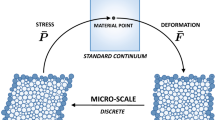Abstract
In the present paper, a homogenization-based two-scale FEM-FEM model is developed to simulate compactions of visco-plastic granular assemblies. The granular structure consisting of two-dimensional grains is modeled by the microscopic finite element method at the small-scale level, and the homogenized viscous assembly is analyzed by the macroscopic finite element method at large-scale level. The link between scales is made using a computational homogenization method. The two-scale FEM-FEM model is developed in which each particle is treated individually with the appropriate constitutive relations obtained from a representative volume element, kinematic conditions, contact constraints, and elimination of overlap satisfied for every particle. The method could be used in a variety of problems that can be represented using granular media.
Similar content being viewed by others
References
Caglioti E, Loreto V, Herrmann H J, Nicodemi M. A tetris-like model for the compaction of dry granular media. Physical Review Letters, 1997, 79(8): 1575–1578
Ribière P, Philippe P, Richard P, Delannay R, Bideau D. Slow compaction of granular system. Journal of Physics Condensed Matter, 2005, 17(24): 2743–2754
Forgerini F L, Figueiredo W. Random deposition of particles of different sizes. Physical Review E: Statistical, Nonlinear, and Soft Matter Physics, 2009, 79(4): 041602
Cates M E, Wittmer J P, Bouchaud J P, Claudin P. Jamming, force chains, and fragile matter. Physical Review Letters, 1998, 81(9): 1841–1844
Dintwa E, van Zeebroeck M, Tijskens E, Ramon H. Torsional stiffness of viscoelastic spheres in contact. European Physical Journal B, 2004, 39(1): 77–85
Bartels G, Unger T, Kadau D, Wolf D E, Kertesz J. The effect of contact torques on porosity of cohesive powders. Granular Matter, 2005, 7(2–3): 139–143
Hu W, Jin F, Zhang C, Wang J. 3D mode discrete element method with the elastoplastic model. Frontiers of Structural and Civil Engineering, 2012, 6(1): 57–68
Lei Yang L, Jiang Y, Li B, Li S, Yang Gao Y. Application of the expanded distinct element method for the study of crack growth in rock-like materials under uniaxial compression. Frontiers of Structural and Civil Engineering, 2012, 6(2): 121–131
Ludewig F, Vandewalle N, Dorbolo S. Compaction of granular mixtures. Granular Matter, 2006, 8(2): 87–91
Uematsu K, Kim J Y, Miyashita M, Uchida N, Saito K. Direct observation of internal structure in spray-dried alumina granules. Journal of the American Ceramic Society, 1990, 73(8): 2555–2557
Uematsu K, Miyashita M, Kim J Y, Kato Z, Uchida N. Effect of forming pressure on the internal structure of alumina green bodies examined with immersion liquid technique. Journal of the American Ceramic Society, 1991, 74(9): 2170–2174
Durán P, Moure C, Jurado J R. Sintering and micro-structural development of ceria-gadolinia dispersed powders. Journal of Materials Science, 1994, 29(7): 1940–1948
Zhang Y, Uchida N, Uematsu K. Direct observation of non-uniform distribution of PVA binder in alumina green body. Journal of Materials Science, 1995, 30(5): 1357–1360
Naito M, Nakahira K, Hotta T, Ito A, Yokoyama T, Kamiya H. Microscopic analysis on the consolidation process of granule beds. Powder Technology, 1998, 95(3): 214–219
Cuitiñoo A M, Alvarez M C Roddy M J, Lordi N G. Experimental characterization of the behavior of granular visco-plastic and viscoelastic solids during compaction. Journal of Materials Science, 2001, 36(22): 5487–5495
Wu Y C, Thompson E G, Heyliger P R. The compaction of aggregates of non-spherical linear viscous particles. Computer Methods in Applied Mechanics and Engineering, 2003, 192(44–46): 4929–4946
Wu Y C, Thompson E G, Heyliger P R, Yao Z H. The compaction of blended aggregates of non-spherical linear viscous particles. Computer Methods in Applied Mechanics and Engineering, 2004, 193(36–38): 3871–3890
Wu Y C. Automatic adaptive mesh upgrade schemes of the step-bystep incremental simulation for quasi linear visco-plastic granular materials. Computer Methods in Applied Mechanics and Engineering, 2008, 197(17–18): 1479–1494
Wu Y, Xiao J, Zhu C. The compaction of time-dependent viscous granular materials considering inertial forces. Acta Mechanica Solida Sinica, 2011, 24(6): 495–505
Hughes T J R, Feijoo G R, Mazzei L, Quincy J B. The variational multi-scale method-a paradigm for computational mechanics. Computer Methods in Applied Mechanics and Engineering, 1998, 166(1–2): 3–24
Wagner G J, Liu W K. Coupling of atomistic and continuum simulations using a bridging scale decomposition. Journal of Computational Physics, 2003, 190(1): 249–274
Park H S, Liu W K. An introduction and tutorial on multiple-scale analysis in solids. Computer Methods in Applied Mechanics and Engineering, 2004, 193(17–20): 1733–1772
Kadowaki H, Liu WK. Bridging multi-scale method for localization problems. Computer Methods in Applied Mechanics and Engineering, 2004, 193(30–32): 3267–3302
Guennouni T, Francois D. Constitutive equations for rigid plastic or viscoplastic materials containing voids. Fatigue and Fracture of Engineering Materials and Structures, 1987, 10(5): 399–418
Gărăjeu M, Suquet P. Effective properties of porous ideally plastic or viscoplastic materials containing rigid particles. Journal of the Mechanics and Physics of Solids, 1997, 45(6): 873–902
Danas K, Idiart M I, Castaneda P P. A homogenization-based constitutive model for isotropic viscoplastic porous media. International Journal of Solids and Structures, 2008, 45(11–12): 3392–3409
Miehe C, Dettmar J, Zah D. Homogenization and two-scale simulations of granular materials for different micro-structural constraints. International Journal for Numerical Methods in Engineering, 2010, 83(8–9): 1206–1236
Nitka M, Combe G, Dascalu C, Desrues J. Two-scale modeling of granular materials: A DEM-FEM approach. Granular Matter, 2011, 13(3): 277–281
Author information
Authors and Affiliations
Corresponding author
Rights and permissions
About this article
Cite this article
Cai, YZ., Wu, YC. Two-scale modeling of granular materials: A FEM-FEM approach. Front. Struct. Civ. Eng. 7, 304–315 (2013). https://doi.org/10.1007/s11709-013-0213-y
Received:
Accepted:
Published:
Issue Date:
DOI: https://doi.org/10.1007/s11709-013-0213-y




